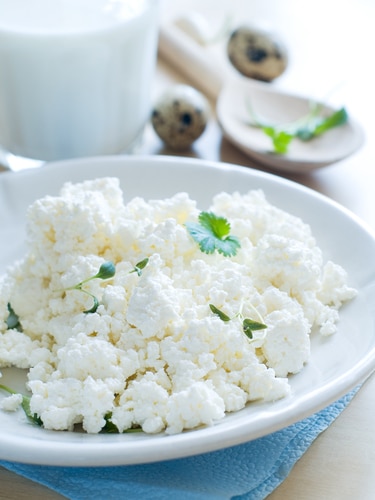 If you work out hard, you need more protein in your diet than a sedentary person does. A diet that’s higher in protein has other benefits as well. Protein is more satiating so you’re less likely to overeat if you start the day with a high protein fare. When you’re choosing your protein sources, there are some good reasons not to neglect dairy.
If you work out hard, you need more protein in your diet than a sedentary person does. A diet that’s higher in protein has other benefits as well. Protein is more satiating so you’re less likely to overeat if you start the day with a high protein fare. When you’re choosing your protein sources, there are some good reasons not to neglect dairy.
A recent study showed that women who ate a diet high in protein from dairy sources lost more body fat and preserved more of their lean body mass than those who ate a lower protein diet with fewer dairy foods. Sound like a good reason to add more dairy to your diet? Here are some dairy foods with the rundown on how much protein they contain.
Cottage Cheese
No wonder cottage cheese has a reputation of being a diet food. A half-cup serving of low-fat cottage cheese only has 90 calories but a whopping 14 grams of protein. It’s also a good source of calcium – but watch out for the salt. Some brands of cottage cheese have as much as 500 milligrams of sodium in a single serving. Fortunately, some supermarkets offer low-sodium cottage cheese, which is a better option. For additional nutritional points, stir in some antioxidant-rich blueberries before spooning in your creamy bowl of cottage cheese.
Cheese
Cheese is a calorie-dense food, so you don’t want to eat too much, but scrambling a little in your eggs makes them more filling and satisfying – and you’re getting additional protein. The amount of protein in cheese varies depending upon the type. Parmesan tops the list with around 10 grams of protein per ounce. Mozzarella, cheddar, and American have between 6 and 7 grams of protein in a 1-ounce serving. Feta cheese is relatively low with only 4 grams of protein per ounce.
Of course, you can also buy low-fat versions of many of these cheeses if you’re worried about calories. To get great taste using less cheese, grate your cheese and serve it on soups or salads. You’ll use less but still enjoy the flavor. Cheese that’s served warm also has a more powerful flavor, meaning you’ll eat less of it.
Yogurt
Whole milk yogurt has 8 grams of protein in an 8-ounce cup. For the ultimate high protein dairy snack, enjoy a cup of Greek yogurt. It has roughly double the protein of regular yogurt with only half the carbs.
Eating yogurt has other health benefits as well. If you chose a yogurt with active cultures, you get the immune-boosting benefits of the probiotic bacteria. These bacteria help to keep your intestines healthy too.
For extra nutritional points, buy plain yogurt and sweeten it yourself with fruit. Always read labels, many flavored yogurts contain lots of added sugar.
Milk
Milk has around 8 grams of protein per cup with whole milk containing slightly less than skim. You can boost the protein content by adding a scoop of whey protein after a workout to send amino acids speeding to the muscles you just worked. After a workout, enjoy a cup of low-fat chocolate milk. Research shows that it’s as effective or even better for muscle recovery after a workout than a sports drink. Here’s to a milk mustache.
The Bottom Line?
You’ve got lots of options when it comes to high protein dairy foods. Enjoy them for a slimmer waistline and better health.
References:
Science Daily. “Foods Rich in Protein, Dairy Products Help Dieters Preserve Muscle and Lose Belly Fat”
Medical News Today. “Chocolate Milk’s ‘Natural’ Muscle Recovery Benefits Match Or May Even Surpass A Specially Designed Carbohydrate Sports Drink”
Self Nutrition Data.
Related Articles By Cathe:
6 Nutrients You Find Only in Meat and Dairy
Are Protein Shakes Causing You to Gain Weight? It Depends on When You’re Drinking Them
What’s the Best Type of Protein for Boosting Muscle Protein Synthesis?
What Impact Do Dairy Foods Have on Appetite?
4 Reasons Boosting the Protein Content of Your Diet Can Help You Lose Weight
6 Common Protein Myths & Facts That Too Few People Get Right

